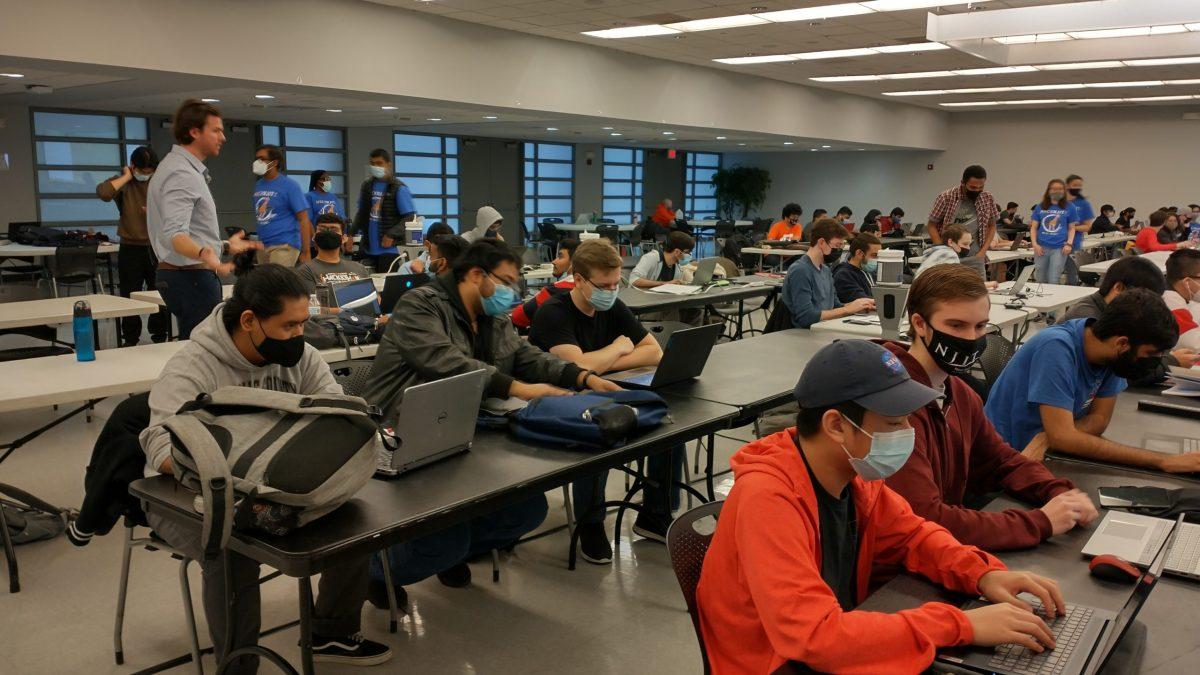At 10 a.m. on Saturday, Nov. 13, over a hundred students gathered virtually on the social platform Discord as well as face-to-face in Campus Center for HackNJIT 2021, a hybrid 24-hour hackathon. The event ran until 5 p.m. on Sunday and only physically included students from NJIT this year due to COVID-19 pandemic regulations, although participants from other schools were allowed to compete virtually.
In the past, with an all in-person event, the hackathon would see most students bringing a sleeping bag to use during resting periods, but due to the hybrid setup, almost no sleeping bags were seen at Campus Center according to Sreya Das, a fourth-year computer science major, event volunteer and organization team member.
HackNJIT 2021 was hosted by the Association for Computing Machinery and the Ying Wu College of Computing, with the theme of a zoo. “I thought it would be fun because it’s a theme that lends itself to having theme-based roles in Discord,” Das, part of the Association for Computing Machinery’s Eboard, explained. “This year, we called organizers, ‘zookeepers,’ and volunteers, ‘veterinarians,’ because the idea was that while zookeepers would keep the show running, the veterinarians support us and help heal any animals who need attention.”
The event was sponsored by Major League Hacking, the official student hackathon league. During previous fully in-person events, the league would provide the Hardware Lab, a table that includes resources like materials and technical support for students to ultimately create a hardware project.
The hybrid setting, however, meant that the table wouldn’t be provided to the hackers. As such, every project submitted was software-based with the exception of one, Thermal Printer Linux Teletype, which won third place in the hackathon.
The project belonged to third-year computer science major Christian Gutierrez. “I was inspired by reading about computer history and how in early computer systems, organizations transitioned from punch cards as a means to writing programs to what modern software developers use as the terminal,” he said. “The terminal is essentially how to direct the computer to do specific things like open up a web browser to low level functions like create a directory at root.”
Gutierrez continued, “The original term is a ‘teletype’ and reading a Wikipedia article made me want to make a modern version of one using off-the-shelf components as a for-fun concept. I checked out Adafruit’s website[, an online learning platform for electronics,] a while ago and noticed that it had a thermal printer – receipt printer; I thought it would be cool to use the teletype idea with that as the output. Since the site also listed that it can be used with a Raspberry Pi, I thought it would be a cool one-day project.”
While he enjoyed making the project, he mentioned that in the future, “I’d probably go for a software-only project, as it’s much less convoluted with needing hardware materials and equipment to work with one another, and it has a lot less prep work.”
In first place, first-year computer engineering major Andrew Gyakobo developed an application called “Cross-Hairs” that had a crude physics engine simulating fluid and particle fluidity. “The whole engine is under the guise of a simple game, where the player has to help a rabbit find a carrot,” he said.
This was the first hackathon Gyakobo participated in, but he had attended a few in the past to observe the competition. “I’m planning to participate in as many hackathons as I can,” he said. “I just love the competitive spirit, ongoing deadlines and stress in the air.”
A team of three graduate students, Ayushi Sangoi, Scott Daniel and Sebastian Fine, came in second place; their project was titled, “Parcel Panther,” to go along with the zoo theme. It “looked to provide a secure method for package recipients to both be able to view their logged packages as well as be automatically notified via email or opt-in text notifications,” according to Fine.
Sangoi added, “We also implemented a discrete version option, which can be used in places like domestic violence shelters to indicate to a person that they have a package available to pick up via text message that doesn’t explicitly talk about the package and the location; it’s kind of like a code.”
Parcel Panther was inspired by the experiences of Sangoi and Fine as Resident Assistants. “It’s a technological solution for improving package deliveries to dorm residents,” Daniel said. He also mentioned that naming the project after panthers was intended to emphasize the increased speed of the system.
“It was fun to see the energy and creativity that participants brought to the event,” he mentioned. “The final projects were entertaining and impressive, and of course, a few projects and teams just crashed and burned!”
“I hope to continue refining my abilities and applying the skills learned in classes towards socially good or interesting project ideas,” Fine said. “I believe that when both the creativity and self-application of course knowledge converge, the true underlying information gained can be demonstrated, and this allows me to better understand my strengths and areas of improvement.”
Sangoi has attended over 20 hackathons in the past and, like many other participants, showed excitement for upcoming ones, saying, “I think I’m a serial hacker!”
































